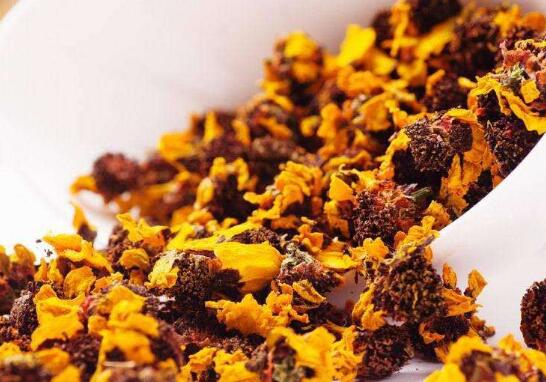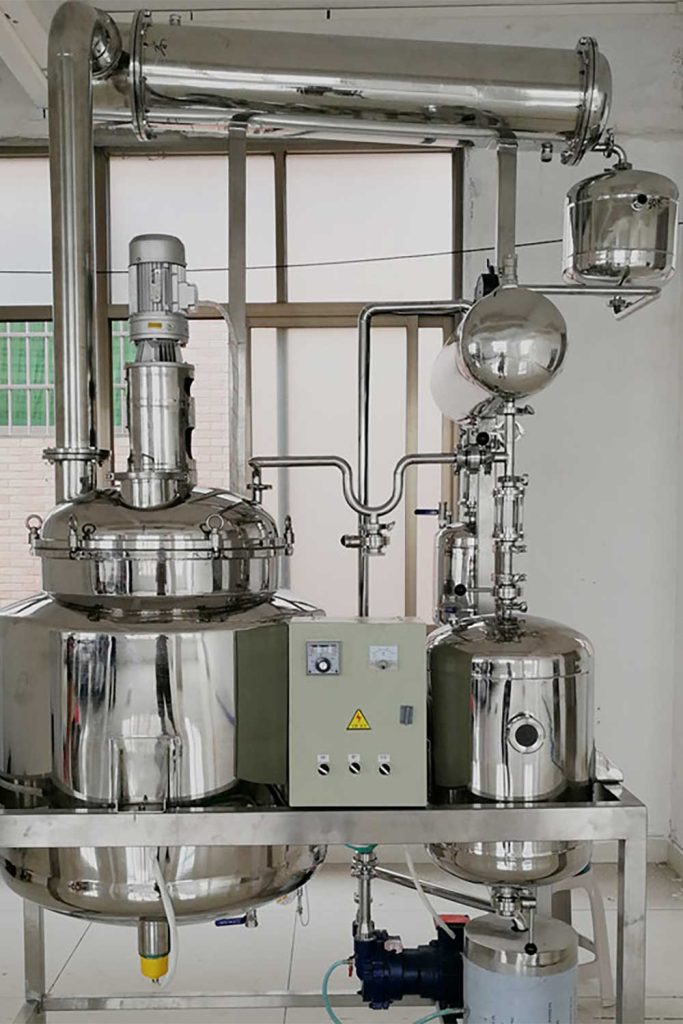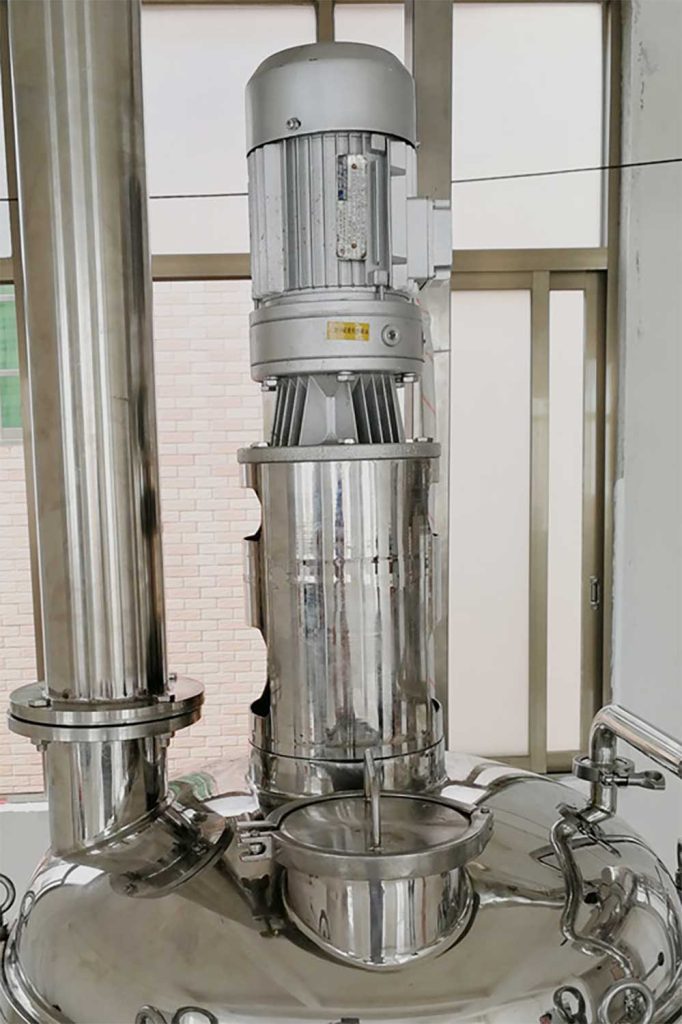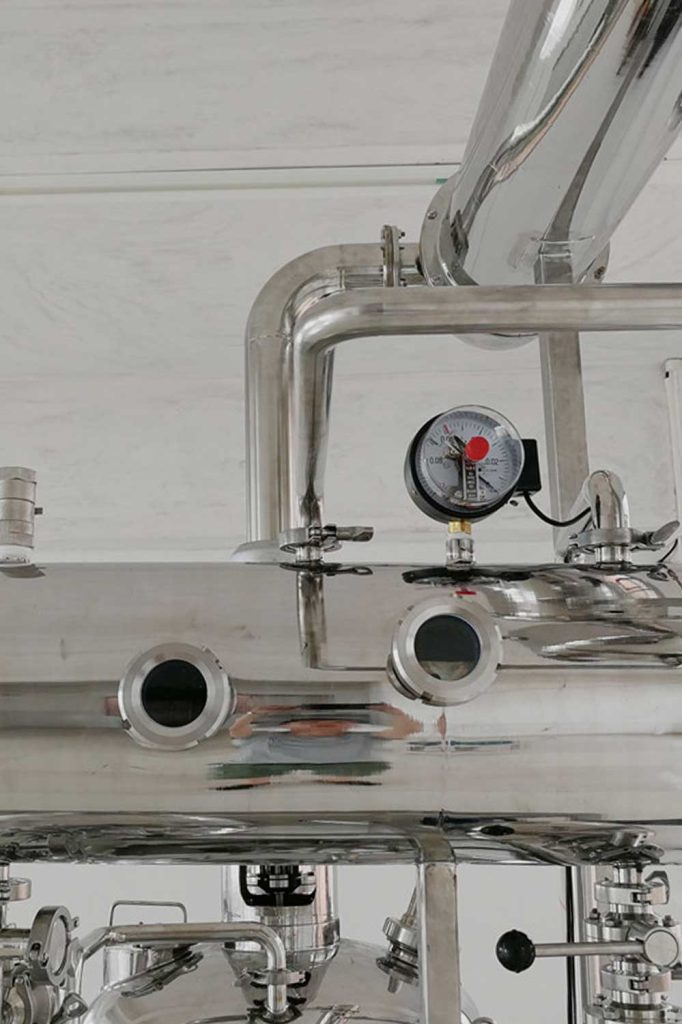
Coreopsis tinctoria Nutt
Coreopsis tinctoria Nutt, also known as “blood chrysanthemum” or “Guliqal” in Uyghur language, is currently the only alpine wild plant in Xinjiang that has the same name as snow lotus and has unique effects.
Medicinal value
It has extremely high medicinal value. Coreopsis tinctoria Nutt contains polyphenols, flavonoids, and saponins, and is also rich in volatile oils. It has many physiological activities such as lowering blood lipids, lowering blood pressure, lowering blood sugar, protecting cells, and anti-oxidation and antibacterial. It has received extensive attention in recent years.
CO2 extraction method
Accurately weighed 300.0g of the crushed Coreopsis tinctoria Nutt raw material into the extraction kettle of the supercritical CO2 extraction device, and closed the device.
Select the set extraction temperature and pressure, pass CO2 into the extractor, and the components in the Coreopsis tinctoria Nutt that can be dissolved in supercritical CO2 will dissolve in the CO2 fluid;
When the CO2 fluid passes through the separator, under the set separation temperature and pressure, the active ingredients of snow chrysanthemum dissolved in supercritical CO2 will be resolved due to the decrease in solubility under the conditions of reduced pressure and elevated temperature.
The separator is separated from CO2, and the extracted snow chrysanthemum active components remain in the separator, while the CO2 is separated from the separator in gaseous form, and the separated CO2 gas is condensed by the condenser and recycled.
After 2 hours of extraction at a temperature of 45°C and an extraction pressure of 25Mpa, the equipment stops running and the snow chrysanthemum extract is taken out from the separator.
CO2 extraction Process
- Pulverization degree:50 mesh
- Extraction pressure: 25 MPa
- Extraction temperature: 45°C
- Separation pressure I: 12 MPa
- Separation I temperature: 50°C
- Separation pressure II: 8 MPa
- Separation II temperature: 40°C
- Extraction time: 120 min
Subcritical water extraction
Weigh 20 g of dry Coreopsis tinctoria Nutt (Qitai area), use PPL lined stainless steel reactor (250 mL), extract 1 h at 150°C, use ether to extract the volatile oil, and then use Drying with anhydrous Na2SO4, the steam distillation essential oil of Tianshan Snow Chrysanthemum is obtained.
Steam distillation
Weigh 100 g of dry Coreopsis tinctoria Nutt (Qitai area), and use steam distillation to extract for 3 hours. After the extraction is complete, use ether to extract the volatile oil, and then dry it with anhydrous Na2SO4. The resulting volatile oil is kept in the refrigerator for later use .
Analysis of Volatile Components
Extract from CO2 extraction
A total of 50 components were identified in the supercritical CO2 extract of Coreopsis tinctoria Nutt, and the relative content accounted for 96.58% of the total.
Among them, olefin compounds (including terpenes) have a total of 9 components, the content of which is only 7.74% of the total mass fraction, which is significantly lower than our previous analysis of headspace solid-phase microextraction-GC-MS in flowers. Proportion (above 85%); but limonene is still the highest content component in its olefins.
The total mass fraction of the seven alcohol compounds is 27.12%, second only to the higher alkane compound (28.59%) with the highest content.
Higher alkane compounds
Higher alkane compounds generally exist in the waxy components of plant stratum corneum, and the high content can reach more than 50% of the plant waxy components.
The coreopsis tinctoria Nutt extract obtained by supercritical extraction method extracts a large amount of waxy components during the extraction process, and during the headspace analysis process, the waxy components are not easy to volatilize, so the detection of such higher alkane components is not To.
It can be seen from the experimental data that the higher alkanes in Coreopsis tinctoria Nutt are alkanes between C21 and C40, with C31 accounting for the highest proportion (10.99%), which is similar to the composition of plant alkanes reported in many literature, followed by C28 And C35.
Free fatty acids
In addition, the free fatty acids from C12 to C18 also account for a considerable proportion (a total of eight components are 18.98%), and these components are also the main components of vegetable waxes.
Other
In addition, the extract also contains 8.81% of aldehydes and ketones, 5.72% of lipid compounds and 0.47% of terpene oxides. These components are also metabolites during plant growth.
Steam distillation extract
Steam distillation products are mainly composed of hydrocarbons (including terpenes), accounting for 71.42% of the total content. In the volatile oil of steam distillation, in addition to the compounds listed in Table 2, the main hydrocarbons are Compounds (including terpenes) and α-pinene (3.31%), α-myrcene (1.89%), morocene-13 (2.15%), trans caryophyllene (1.16%) and trans Farnesene (1.39%).
A total of 18 alcohol compounds were obtained in the steam distillation products. There are trans-p-menthol-2,8-dienol (0.51 %), tau-cadinol (0.38%), (-)-spartol (0.35%), 2,5-dimethyl-1,5-hexadiene-3,4-diol (1.34% ), trans-p-2,8-menthadien-1-ol (1.02%), verbenaol (0.37%), 1,2,5,6-tetramethyl-bicyclo[3.3.0] Octan-3-ol (0.58%), p-menthol-1(7), 8(10)-diene-9-ol (0.35%), 6-isopropenyl-4,8a-diyl-1 ,2,3,5,6,7,8,8a-octahydro-naphthalene-2-ol (0.65%), cumyl alcohol (0.33%), (Z)-2-nonen-1-ol (0.27% ) And p-santalol (0.35%);
The 8 ketones and aldehyde compounds identified are: L-carvone, garlic-4(14)-en-1-one, cis-dihydrocarvone (0.29%), 6,10,14-trimethyl-2-pentadecanone (0.48%), p-menth-1-en-9-aldehyde (0.35%), geranyl acetone (0.41%) and β-ionone (0.41%), only one ester compound (linalyl acetate (1.39%)) was identified, and 7 terpene oxides (4.19%), caryophyllene oxide (1.28%) Is the most important ingredient. In addition, other compounds identified are n-palmitic acid (1.00%), myristic acid (0.37%), lauric acid (0.77%), acetic acid (0.70%), caproic acid (0.63%).
Subcritical water extract
In the volatile oil extracted by subcritical water, the content of hydrocarbons (including terpenes) is relatively low. Only 8 hydrocarbons have been identified, as well as verbena (0.33%) and behenyl (0.45%), (E)-2,6-dimethyl-1,3,5,7-octatetraene (0.39%), 1,3,8-p-menthtriene (0.34%).
The ester compound in the volatile oil extracted by subcritical water is the main component, and the content accounts for 49.82% of the total.
This may be due to the high temperature of the extraction process which caused the oxidation and further esterification of the hydrocarbon compounds in the Tianshan snow chrysanthemum .
Ester compounds
(Z)-9-octadecenoic acid methyl ester (16.01%), hexadecanoic acid methyl ester (10.39%), 3-(4-hydroxyphenyl)-2-acrylic acid Methyl (2.28%) (Z)-9-hexadecenoic acid methyl ester (5.68%), methyl octadecanoate (2.35%), (Z,Z)-9,12-octadecadiene Methyl tetradecanoate (4.03%), methyl tetradecanoate (1.57%), (Z,Z,Z)-9,12,15-octadecatrienoate (2.13%) and (E)-10 -Methyl unadecenoate (1.79%).
In addition to the 14 alcohol compounds (21.61%) identified, the content of ethanol is relatively high.
In addition to those listed in Table 2, there are 2,5-dimethyl-1,5-hexadiene-3,4-diol (2.25%), (R)-2-butanol (0.31%), cis-authaltanol (0.38%), p-menthol-1(7), 8(10)-diene-9-ol (0.35 %), cumyl alcohol (0.70%), verbenaol (0.55%), 1,8-1-monadien-4-ol (0.67%) and terpineol (0.49%); 4 aldehydes and ketones Among the compounds (3.81%), L-carvone (2.48%) is the main component, and only one terpene oxide α-phellandrene epoxy compound (1.36%) was identified.
Among the other components, 1 , 2-Benzenediol (6.03%) is its main component.
Steam vs subcritical water vs CO2 extraction
The content of hydrocarbons in supercritical extracts is lower than steam distillation but higher than subcritical water extraction.
Many oxygen-containing compounds were also identified in the two essential oils.
The volatile components of the Coreopsis tinctoria Nutt extract obtained by supercritical CO2 and subcritical water extraction were compared, and compared with the traditional steam distillation method.
The results showed that the extract obtained by the traditional steam distillation method was based on hydrocarbons. Mainly, due to the high temperature used in the extraction process of subcritical water, most of the hydrocarbons in the extract have been oxidized or esterified, and esters are the main components.
The products obtained by this method are more suitable for use in flavor formulations.
In addition to terpenoids, the supercritical CO2 extract retains more waxy components (higher alkanes) of the Coreopsis tinctoria Nutt plant. In particular, the content of behenyl alcohol is relatively high and has higher antibacterial and antiviral activity. If used as an essential oil, it still needs further refinement.
What is steam distillation?
The steam distillation method refers to soaking and moistening the coarse powder or fragments of materials (such as natural aromatic compounds) containing volatile components, and then heating them with direct fire for distillation or steam distillation. The volatile components in the medicinal materials are brought out with steam distillation, and the distillate is collected after condensation. Generally, one more distillation is required to improve the purity and concentration of the distillate. Finally, a certain volume of distillate is collected; but the number of distillations should not be too much, to avoid oxidation or decomposition of some components in the volatile oil. The basic principle of this method is that according to Dalton’s law, the total vapor pressure of a liquid mixture that is insoluble and does not have chemical effects is equal to the sum of the saturated vapor pressures (ie partial pressures) of each component at this temperature. Therefore, although the boiling point of each component itself is higher than the boiling point of the mixed liquid when the sum of the partial pressures equals the atmospheric pressure, the liquid mixture begins to boil and is distilled out.



Types of steam distillation
Generally, steam distillation is divided into three forms; water distillation, water distillation, and steam distillation. When dealing with various aromatic plants, it is often necessary to perform some pretreatment on the plant’s raw materials before extracting the essential oils by distillation. If it is a grass plant or the oil extraction part is flowers, leaves, flower buds, flower spikes, etc., it can generally be directly loaded into the distiller for processing; but if the oil extraction part is rhizomes, etc., it generally needs to be washed, sun-dried or dried in the shade, and crushed. In addition, some aromatic plants need to be fermented first.
Water distillation
The raw materials are placed on the sieve plate or directly into the distillation pot, water is added to the pot to soak the material layer, and the bottom of the pot is heated.
Water distillation
(Water-separated distillation) The raw materials are placed on the sieve plate, and the amount of water added to the pot must meet the distillation requirements, but the water surface should not be higher than the sieve plate, and it can ensure that the water does not splash the material layer when it boils to evaporate. Generally, reflux water is used to keep the water in the pot. The amount of water is constant to meet the sufficient saturated steam required for steam operation, so a sight glass can be installed at the bottom of the pot to observe the water level.
Direct steam distillation: install a ring pipe with holes under the sieve plate, and the external steam is directly sprayed through the small holes and enters the sieve holes to heat the raw materials, but the water dispersion effect is not sufficient, and the water dispersion should be carried out outside the pot in advance. Internal distillation is fast and easy to change to pressurized distillation.
Water diffusion steam distillation
This is a novel distillation technique. The water vapor enters from the top of the pot, and the steam gradually penetrates the material layer from top to bottom. At the same time, the air in the material layer is pushed out. The steam is percolation type, the distillation is uniform, consistent and complete, and the water-oil condensate enters the condenser faster, so the obtained essential oil has better quality, higher yield, lower energy consumption, short distillation time and simple equipment.
Features OF steam distillation
The steam distillation method is only suitable for the extraction of volatile components, which can be distilled with steam without being destroyed, do not react with water, and are insoluble or insoluble in water. Most of these components have a boiling point above 100°C, are immiscible or only slightly soluble in water, and have a certain vapor pressure around 100°C. When heated with water, when the sum of its vapor pressure and the vapor pressure of water is one atmosphere, the liquid begins to boil, and the water vapor brings out the volatile substances. For example, the volatile oil in Chinese herbal medicine, some small-molecule alkaloids—ephedrine, choline, arecoline, and some small-molecule phenolic substances. Paeonol, etc., can be extracted by steam distillation. Some volatile components are slightly more soluble in water, and the distillate is often re-distilled, and the volatile oil layer is separated from the first distilled part, or the components are extracted by salting out the water layer of the distillate and using a low-boiling solvent. . For example, the preparation of rose oil and original pulsatilla is mostly made by steam distillation.
The steam distillation method needs to heat the raw material and is not suitable for the extraction of chemically unstable components.
What is subcritical water extraction?
Subcritical water is a chemical term, also known as super-heated water, high-pressure hot water, or hot liquid water, which means that under a certain pressure, the water is heated to a high temperature above 100°C and below the critical temperature of 374°C, and the water remains in a liquid state.
In the subcritical state, the hydrogen bonds, ionic hydration, ionic association, and cluster structure of the fluid microstructure have changed. Therefore, the physical and chemical properties of subcritical water are quite different from those of water at room temperature and pressure.
Under normal temperature and pressure, the polarity of water is strong. In the subcritical state, as the temperature increases, the hydrogen bonds of subcritical water are opened or weakened, so that water is extracted from high to low. In this way, by controlling the temperature and pressure of subcritical water, the polarity of water can be changed in a wide range, to realize continuous extraction of effective components from water-soluble components to fat-soluble components in natural products, and achieve selective extraction.
In addition, since subcritical water extraction uses cheap, non-polluting water as the extraction agent, subcritical water extraction technology is regarded as a transformative technology with green environmental protection and broad prospects.
Subcritical water extraction method
The water is heated to above the boiling point and below the critical point, and the system pressure is controlled to keep the water in a liquid state. The water in this state is called subcritical water, and it is also called super hot water and high temperature water in the literature. Under normal conditions, water is a polar compound. Under the pressure of 505 kPa, as the temperature increases (50~300℃), its dielectric constant decreases from 70 to 1, that is to say, its properties gradually change from strong polarity to non-polarity. Extract from high to low. Under conditions of high temperature and pressure, the polarity of water decreases, and non-polar compounds can be extracted; under conditions of low temperature and pressure, the polarity of water increases, and polar compounds can be extracted.
The principle of subcritical water extraction process
The critical pressure and critical temperature of the water are 22.1 MPa and 374℃, respectively. Under the condition of f>374℃, p>22.1 MPa, the dielectric constant of water is 5~15. Water that is in a liquid state at a low-temperature pressure slightly lower than 374.2 ° C and 22.1 MPa is called “subcritical water”.
In the actual extraction process, since the influence of pressure on the dielectric constant is not as great as that of temperature, the dielectric constant of water is mainly controlled by adjusting the temperature. The extraction method of subcritical water is called the “green treatment method” because it is a treatment technology for water under high heat and pressure without using acid, alkali, and catalyst. In addition, the extraction can be completed in a short time of several seconds to several minutes, so there is an advantage that continuous processing is possible.
Subcritical water can be used to extract analytes in various solid samples and various difficult-to-extract natural products, and can also determine highly volatile substances and highly polar substances by controlling temperature and pressure. Subcritical water has the properties of “strong dissolved organic matter in water” and “strong decomposition force” which are different from ordinary water. Taking advantage of this property, supercritical water and subcritical water are utilized to extract useful components (including extraction of decomposed products following decomposition reactions). At the same time, since this property is related to temperature and pressure: corresponding changes occur with the difference between the two, so the extraction method can be adjusted and controlled. That is to say, use components that have been reduced in molecular weight due to hydrolysis reactions can be extracted, or use components that have been converted into substances by thermal decomposition and oxidative decomposition reactions can also be extracted by this method.
Advantages
As a new sample pretreatment technology, subcritical water extraction has the following advantages compared with traditional pretreatment technology: simple equipment, short extraction time, and by changing the extraction temperature, the polarity of water can be changed, so that selective It extracts organic compounds of different polarities in the sample matrix, and it uses pure water as the extractant, no or little organic solvent, so it has no or little pollution to the environment.
What is supercritical CO2 extraction process?
Among several supercritical fluid (abbreviated SCF) technologies, the earliest developed, most researched and industrialized product technology is undoubtedly the supercritical fluid extraction (abbreviated SFE) technology.
Supercritical fluid extraction (SFE) is the process of separating one component (the extractant) from another (the matrix) using supercritical fluids as the extracting solvent.
Supercritical CO2 extraction (SCFE) is used particularly in the food, beverage, cosmetics and pharmaceutical industry for extracting natural substances, aromas, fats, oils, waxes, polymers, enzymes and colourants in their supercritical physical state.
CO2 is a natural and environmentally-friendly solvent which has advantages over synthetic and harmful media such as n-hexane when it comes to sustainability.